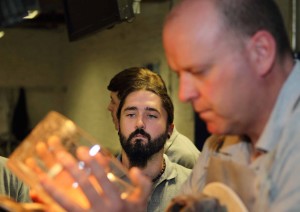
Waterford Crystal cutting apprentice Chris Phelan noting Master Cutter Damien O'Regan's skills. A 'Glass Museum' concept was mooted at a conference held in WIT last weekend.
In the week in which Waterford Crystal pensioners finally received their monies, a Glass Symposium at WIT last weekend heard about the prospect of creating of a new ‘Glass Museum’ in a city synonymous with the crafting and production of crystal.
As part of ‘The Glass City’ project initiated by Róisín De Buitléar, an inspirational and visionary artist, the Symposium held at WIT was themed: ‘Future Legacy’ with the academic subtitle: ‘Contemporary contexts for glass in Tourism, Design & Technologies’.
While some might say it’s still too soon to be talking about the future, it became evident over the weekend that if the legacy and the human and community heritage is allowed to fade in Waterford, it will be much harder to ‘refire’ Waterford’s “human furnace” and harness and sustain such craft skills.
Keynote speaker Susanne Joker Johnsen spoke about the Swedish Kingdom of Glass and the importance of “local identity and cultural production”, as across Europe, industrial glass processes and large factories were closed or closing, and how glass studios were emerging via tourism – referring to six small glass studios on a Danish island.
Chuck Lopez, “the technology man” at Pratt Fine Arts Centre in Seattle, Washington spoke about “community access programmes” since 1976, where glass ‘Hot Shops’ or furnaces with kilns providing spaces for kiln and flame are working.
This is in addition to ‘cold’ working in painting, engraving and etching. Many at Pratt have other day jobs and came in the evenings to work in a ‘practice-based’ rather than an academic environment.
The Symposium also heard from Mark Angus, an English architectural glass artist working in the German glass village of Frauneau.
He was the “personal and thinking out loud” ideas man, adding that Waterford must respect its heritage and that re-growth could be slow.
However, he referenced the prospect of a Glass Museum where “hands-on skills” could be demonstrated as a “cultural tourism experience”. He was not advocating a “preservation society” but a “trail of artworks as a Glass City”, continuing Waterford’s proud industrial craft tradition.
Yann Greinenberger from Meisenthal, a village of about 700 people in Western France, got to the ‘inspirational heart’ of the Symposium as he outlined the 40-year gap since the closure of the industrial factory model, which has been replaced via a transmission of skills.
His comments resonated with many as he explained how deep the scars went over those years. Today, Meisenthal employs about 17 glass workers and is an inspirational place where 25 different art schools send students for one-week residencies.
Representatives from Waterford City & County Council, the Viking Triangle and regional education stakeholders have visited Meisenthal.
Mr Greinenberger spoke via an interpreter yet it was his comments that occupied a lot of the discussions and the various ‘breakout’ groups during the weekend.
The guest speaker list at the Symposium was an impressive one, with contributors from Denmark, France, England, Germany, Washington and California.
An emerging theme was not about restoring or reliving the past but about considering and researching the demands for glass into the future.
Speaker after speaker talked about small inspirational groups of people starting up and developing ‘community access studios’, where one or two people ‘step up to the plate’ and want to make it happen.
Among the list of attendees were a small number of ex-Waterford Crystal workers who still wish to work in the trade they honed over decades in Kilbarry.
Tom O’Toole, the Head of School of Business at WIT, an institution experiencing its own development difficulties, delivered the opening address, and spoke about education and training and instanced a 1948 document for a Central Technical Institute course where the tutors were Miroslav Havel, Charles Bacik and Robert Burke (for Drawing).
O’Toole mentioned the “apprentice led education” and a late 90s Degree programme in Glass Technology at WIT, and emphasised the need for “commercialising” any future plans.
In her emotional closing statement, Róisín De Buitléar stressed: “For too long the company – Waterford Crystal – owned the glass, but now, the people and the city are the owners of the tradition and the future of the Glass City.”

